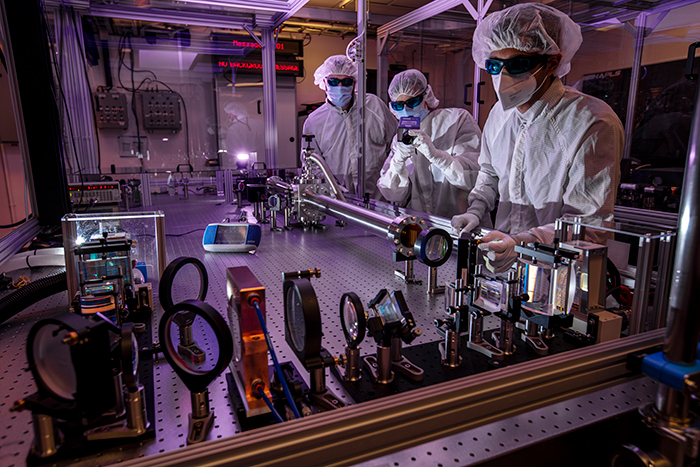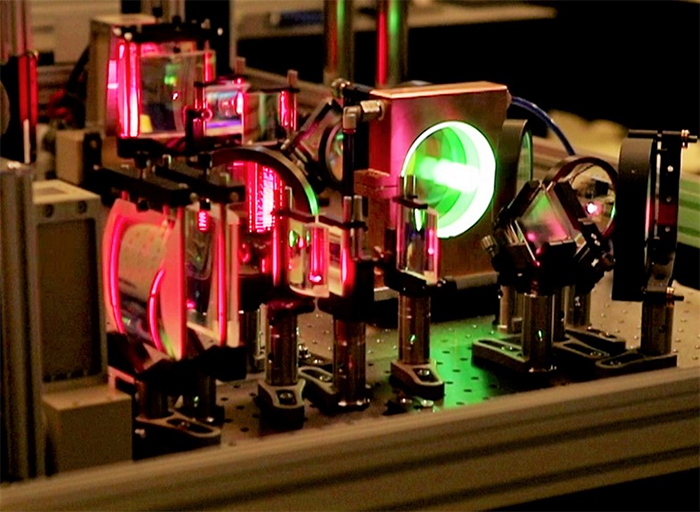LLNL’s ‘BAT Laser’ R&D Delivers Big Results
March 9, 2023
 Left to right: Drew Willard, Brendan Reagan, and Issa Tamer work on the Tm:YLF laser system. Photos by Jason Laurea
Left to right: Drew Willard, Brendan Reagan, and Issa Tamer work on the Tm:YLF laser system. Photos by Jason Laurea LLNL’s research and development of the Big Aperture Thulium (BAT) laser has been living up to its name, delivering big results in a small package.
BAT is a novel petawatt-class laser conceptual design using thulium-doped yttrium lithium fluoride (Tm:YLF) as the laser gain medium, theoretically allowing it to efficiently deliver petawatt-class, ultra-short laser pulses at hundreds of kilowatts of average power—by far surpassing the current state of the art of similar lasers.
“To the best of our knowledge, these are over 25 times the highest pulse energies reported by any laser architecture operating near 2-micron wavelength in the world,” said LLNL physicist Issa Tamer, lead author of a paper featuring these results that was published in Optics Express. The paper was selected as an editor’s pick in the publication’s Dec. 19 edition.
As a powerful and compact laser, the BAT laser architecture could potentially prove transformative for applications like laser-plasma acceleration, proton acceleration for cancer therapy, laser shock peening to repair microcracks in critical aircraft components, and EUV lithography for high-volume chip manufacturing.
Work Funded as Disruptive Research
“It is both exciting and gratifying to discover and develop a previously under-appreciated laser material and then to work with a high-performing team to unlock its full potential,” said Tom Spinka, the program element leader for laser development of NIF’s Advanced Photon Technologies program.
After modeling predicted that Tm:YLF’s advantageous material characteristics could enable next-generation high peak and average power performance, LLNL funded the majority of the work through a Disruptive Research Laboratory Directed Research and Development (DR LDRD) project.
“The LDRD ecosystem at LLNL, and the Disruptive Research track in particular, is key to enabling the kind of high-risk, high-reward research that can leapfrog existing technologies and evolutionary developments,” added Spinka, the DR LDRD project’s principal investigator. “It’s also a great opportunity for upcoming scientists and thought leaders to hone their skills and prepare for larger roles in programmatic work.”
Tamer fits the profile of an upcoming scientist. He came to LLNL in 2020 as a postdoc and became a full-time employee in 2022. His path to becoming a laser scientist began when he was a teenager in Arizona, doing computer installation and repair as a side job.
“I was at a customer’s house, and he happened to have the Wikipedia page for the National Ignition Facility open on his monitor,” he recalled. “I was intrigued, so on my own time I learned more about NIF and decided that’s where I wanted to work.”
He studied optics at the University of Arizona and as an undergraduate worked at Lasertel (now known as Leonardo Electronics US Inc.), which manufactures specialized high-power laser diodes. He then earned his Ph.D. in laser physics from Friedrich Schiller University Jena in Germany.
As a laser physicist, working on the BAT laser, he said, has been a dream come true.
Recording-Breaking Pulse Energies
Tm:YLF is not a newly discovered material, but it took advanced laser diode technology to harness its potential. Tm:YLF emits in a broad spectrum near 1.9-micron wavelength that supports femtosecond pulses with superior energy storage and extraction capabilities. An energy storage lifetime of 15 milliseconds and peak absorption near 800 nanometers enables it to be pumped with commercially available continuous wave laser diodes.
Despite the large difference in pump and seed photon energies, which often leads to large heat loads within the laser material, Tm:YLF can instead be operated at a low quantum defect due to a two-for-one cross-relaxation interaction that can result in two excited Tm3+ ions induced for each pump photon absorbed.
Furthermore, amplification occurs in a steady-state manner through the multi-pulse extraction technique, thereby allowing for efficient energy extraction at a high average intensity achieved using low individual pulse fluences and a high-repetition-rate pulse train. With continuous pumping and effectively continuous extraction, the BAT laser exhibits true average power behavior, allowing for a free exchange of energy and repetition rate to utilize the same system for various applications.
“In true LLNL fashion and in a manner appropriate for the Big Aperture Thulium concept name,” Tamer said, “the APT group procured the largest Tm:YLF boule ever grown to withstand the potential world-record-breaking pulse energies extractable from this laser material.”
 The compact, high-energy Tm:YLF demonstrator for the Big Aperture Thulium (BAT) laser concept.
The compact, high-energy Tm:YLF demonstrator for the Big Aperture Thulium (BAT) laser concept. The DR LDRD team constructed a compact Tm:YLF laser system, taking up a small portion of an optical table. After a successful first test using a 4-pass amplifier, they made simple modifications, including increasing pump power by stacking laser diode arrays. They demonstrated more than 20 joules in nanosecond-duration pulses, and more than 100 joules in millisecond-duration pulses with nearly 100J/cm3 of extractable energy density—more than two orders of magnitude higher than a more traditional Nd:Glass amplifier.
In addition, the experiment demonstrated efficient, high-power multi-pulse extraction in Tm:YLF—through an amplification of a multi-kHz pulse train burst up to 3.6kW with 19 percent optical-to-optical efficiency—as well as high-energy chirped-pulse amplification in Tm:YLF for the first time.
“We believe that these results highlight the promising capabilities of Tm:YLF as the leading material candidate for the BAT laser concept,” Tamer said, “and open the path to continued development of high peak and average power mid-infrared solid-state lasers.”
The researchers are now working to demonstrate femtosecond pulse durations (currently 100 millijoules with ultrashort compressible pulses), with upcoming experiments planned to achieve joule-level pulses compressed to sub-300 femtoseconds.
Joining Tamer and Spinka on the DR LDRD team and the paper were LLNL colleagues František Batysta, Andrew Church, Justin Galbraith, Thomas Galvin, Zbyněk Hubka, Glenn Huete, Leily Kiani, Hansel Neurath, Brendan Reagan, Kathleen Schaffers, Emily Sistrunk, and Drew Willard.
—Patricia Koning
Follow us on Twitter: @lasers_llnl



